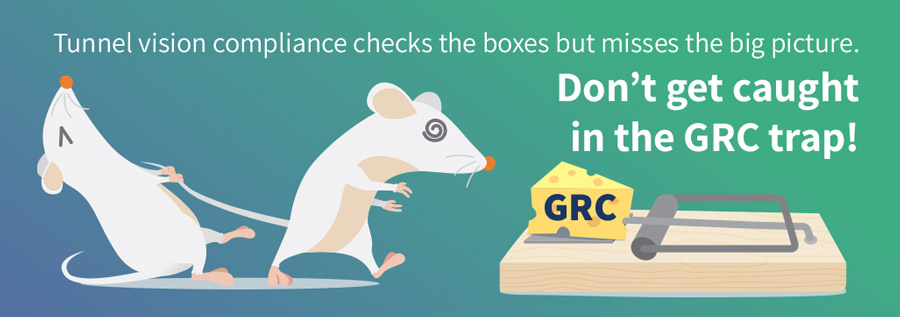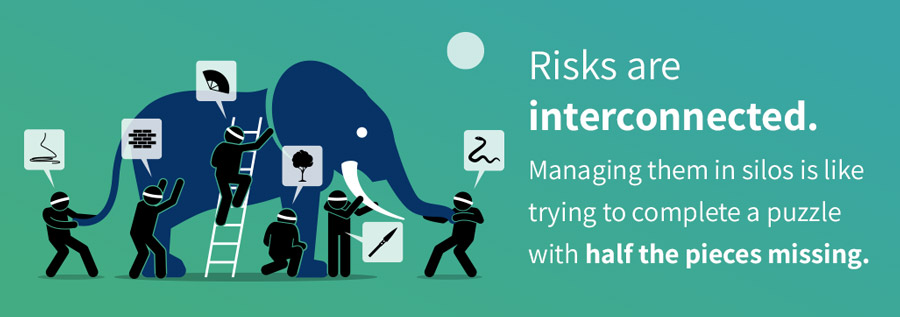Why Are So Many Companies Stuck in GRC? It’s Time for a Change!
Last Updated: July 16, 2024
Let’s be real: the risk management world is buzzing, but far too many companies remain entrenched in outdated Governance, Risk, and Compliance (GRC) software. Seriously, why? And more importantly, how many risk management failures will it take for companies to reevaluate their relationship with GRC? Let’s get to the bottom of these burning questions and explore why taking a proactive risk-based approach is the way to go.
The GRC Trap: Why Companies Are Stuck
Legacy Investments and Inertia: Companies have invested substantial time and resources into GRC systems. This often results in technological inertia, where the cost of switching to a new system seems prohibitive. The result? Companies are trapped in an “if it isn’t broken, don’t fix it” mindset and a reluctance to jump ship to newer, more effective solutions.
Vendor Lock-In: GRC giants like ServiceNow have their claws deep into company operations with their sprawling product suites. This dependency makes the thought of switching seem like a nightmare. Companies may fear the potential disruptions and costs associated with migrating to a new platform.
Compliance Comfort Zone: GRC software excels at one thing: compliance. Companies laser-focused on regulatory requirements feel cozy in their GRC bubble. But here’s the catch—this narrow focus often overlooks the broader, proactive elements of risk management that ERM addresses.
Market Perception: GRC vendors hold a strong market presence and brand recognition. Their widespread use creates a false sense of security, leading companies to believe that if everyone else is using GRC solutions, it must be the right choice. This is a classic bandwagon fallacy, which logical reasoning easily disproves.
The Fallacy of GRC: Why It’s Outdated
GRC had its day in the sun, but let’s face it—it’s a dinosaur in today’s fast-paced, interconnected world. Here’s why GRC is falling flat on its face:
Reactive, Not Proactive: GRC systems are designed to react after the fact, meaning companies are always scrambling to catch up. In a world where risks evolve at lightning speed, this approach is just not cutting it. Companies need systems that can see around corners and squash risks before they blow up.

Tunnel Vision Compliance: Sure, GRC is a champ at ticking the compliance boxes, but it often does this at the expense of true risk management. Companies get so bogged down in meeting regulations that they overlook other critical risks that could derail their strategic goals. It’s like focusing on the checkboxes while the house is on fire.
Siloed Approach: GRC tools are notorious for being compartmentalized, focusing on niches like IT or finance. This siloed mentality keeps companies from seeing the full risk picture. Risks are interconnected, and managing them in isolation is like trying to complete a puzzle with half the pieces missing.
Lack of Strategic Alignment: GRC systems often operate in their own little bubble, disconnected from the company’s strategic planning processes. This gap means risk management isn’t aligned with the overall goals and objectives, limiting its impact and strategic value.
Static and Inflexible: The risk landscape is constantly shifting, but GRC systems are often stuck in the mud, struggling to keep up. This rigidity leaves companies exposed to new and evolving threats, making them sitting ducks in a dynamic environment.
Take ServiceNow, for instance. Known as a leader in IT service management, ServiceNow’s GRC solutions do a decent job managing compliance and operational risks within IT silos. But here’s the kicker—they fall short on delivering a holistic, enterprise-wide view of risk. These tools treat risk management as an afterthought rather than a strategic priority, lacking the foresight and integration needed for comprehensive risk management.
In today’s world, playing catch-up just doesn’t cut it. It’s time to ditch the outdated GRC playbook and embrace a proactive, integrated approach to risk management.
ERM: The Superior, Proactive Approach
Enter ERM, the game-changer in risk management. Here’s why ERM kicks GRC to the curb:
Proactive Risk Identification: ERM is like having a sixth sense for sniffing out potential risks before they wreak havoc. This forward-thinking approach lets companies squash threats early, stopping them from escalating into full-blown crises. No more firefighting—ERM keeps you a step ahead, ready to tackle risks head-on.
Boardroom-Ready Strategy: ERM isn’t an afterthought—it’s woven into every decision you make. With risk considerations baked into strategic planning, ERM ensures that your risk management aligns perfectly with your company’s goals. Get ready to impress the board with insights that support and enhance your business objectives.

Panoramic Risk View: Say goodbye to silos and hello to a holistic view of your risk landscape. ERM breaks down barriers, promoting cross-departmental collaboration so all risks are managed effectively, no matter where they originate. No more “blind men and the elephant” problem—ERM gives you the whole picture.
Accountability and Transparency: ERM fosters accountability and transparency. With crystal-clear visibility into risk ownership and management processes, everyone knows their roles and responsibilities. This clarity ensures nothing falls through the cracks, fostering a proactive approach to risk management at all levels.
Surface Hidden Connections: Risks don’t stop at your company’s door; they extend far beyond your immediate partners. When incidents like the Change Healthcare breach or SVB collapse happen, ERM ensures you know your connections and can take swift, informed action.
ERM is not just an upgrade from GRC—it’s a complete transformation. It offers a proactive, strategic, and holistic approach to risk management that is essential for navigating today’s complex business environment. Companies that embrace ERM will be better equipped to manage risks, ensure accountability and transparency, and secure their future in an increasingly uncertain world.
How to Break Free From GRC
For companies still stuck with outdated GRC software like ServiceNow, it’s time to wake up. Recognize the limitations and embrace the strategic powerhouse that is ERM. Here’s how to make the switch and bring your risk management into the future:
- Assess Your Current System: Start by evaluating the gaps and inefficiencies in your existing GRC setup. Identify areas where it falls short, particularly in proactive risk identification and strategic alignment.
- Engage Stakeholders: Get buy-in from key stakeholders, including your board, by highlighting the benefits of ERM—enhanced resilience, comprehensive risk visibility, and strategic integration.
- Choose the Right ERM Solution: Select an ERM platform that offers a forward-thinking, integrated approach. Look for features like real-time risk monitoring, strategic risk alignment, and advanced analytics.
- Plan the Transition: Develop a clear transition plan. This includes migrating data, training your team, and setting new processes to ensure a smooth shift from GRC to ERM.
- Monitor and Adapt: Continuously monitor the effectiveness of your ERM program. Be prepared to adapt and refine your approach as needed to stay ahead of emerging risks.
At LogicManager, we’re all about ERM. Our solutions go beyond ensuring compliance by empowering organizations to uphold their reputation, anticipate what’s ahead, and improve business performance through strong governance.
Ready to move forward? LogicManager has your back every step of the way. Schedule a call with one of our risk experts to learn how you can break free from GRC.
